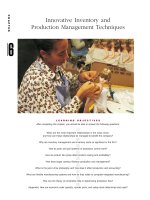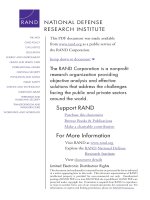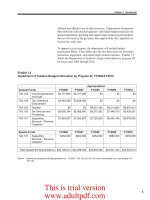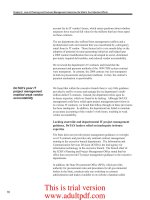Lecture Principle of inventory and material management - Lecture 16
Bạn đang xem bản rút gọn của tài liệu. Xem và tải ngay bản đầy đủ của tài liệu tại đây (917.51 KB, 41 trang )
Lecture 16
Purchasing and Supply Chain (continued)
Books
•
Introduction to Materials Management, Sixth Edition, J. R. Tony Arnold, P.E., CFPIM, CIRM, Fleming
College, Emeritus, Stephen N. Chapman, Ph.D., CFPIM, North Carolina State University, Lloyd M.
Clive, P.E., CFPIM, Fleming College
•
Operations Management for Competitive Advantage, 11th Edition, by Chase, Jacobs, and Aquilano, 2005,
N.Y.: McGrawHill/Irwin.
•
Operations Management, 11/E, Jay Heizer, Texas Lutheran University, Barry Render, Graduate School of
Business, Rollins College, Prentice Hall
Objectives
•
•
•
•
•
•
•
•
•
•
Supply Chain Strategies
Suppliers
Vertical Integration
Managing Supply chain
Issues in integrated supply chain
Opportunities in integrated supply chain
Keiretsu Networks
EProcurement
Distribution
Managing supply chain performance
Supply Chain Strategies
Negotiating with many suppliers
þ
Long-term partnering with few
suppliers
þ
Vertical integration
þ
Keiretsu
þ
Virtual companies that use suppliers
on an as needed basis
þ
Many Suppliers
Commonly used for commodity
products
þ
Purchasing is typically based on price
þ
Suppliers compete with one another
þ
Supplier is responsible for technology,
expertise, forecasting, cost, quality,
and delivery
þ
Few Suppliers
Buyer forms longer term relationships
with fewer suppliers
þ
Create value through economies of
scale and learning curve
improvements
þ
Suppliers more willing to participate in
JIT programs and contribute design
and technological expertise
þ
Cost of changing suppliers is huge
þ
Vertical Integration
Vertical Integration
Examples of Vertical Integration
Raw material
(suppliers)
Iron ore
Backward
integration
Steel
Current
transformation
Automobiles
Forward integration
Finished goods
(customers)
Distribution
systems
Dealers
Silicon
Integrated
circuits
Farming
Flour milling
Circuit boards
Computers
Watches
Calculators
Baked goods
Vertical Integration
Developing the ability to produce goods or
service previously purchased
þ
Integration may be forward, towards the
customer, or backward, towards suppliers
þ
Can improve cost, quality, and inventory but
requires capital, managerial skills, and
demand
þ
Risky in industries with rapid technological
change
þ
Keiretsu Networks
A middle ground between few suppliers and
vertical integration
þ
Supplier becomes part of the company
coalition
þ
Often provide financial support for suppliers
through ownership or loans
þ
Members expect long-term relationships and
provide technical expertise and stable
deliveries
þ
May extend through several levels of the
supply chain
þ
Virtual Companies
Rely on a variety of supplier relationships to
provide services on demand
þ
Fluid organizational boundaries that allow the
creation of unique enterprises to meet
changing market demands
þ
Exceptionally lean performance, low capital
investment, flexibility, and speed
þ
Managing the Supply Chain
There are significant management issues in
controlling a supply chain involving many
independent organizations
Mutual agreement on goals
þ
Trust
þ
Compatible organizational cultures
þ
Issues in an Integrated Supply Chain
Local optimization - focusing on local profit or
cost minimization based on limited
knowledge
þ
Incentives (sales incentives, quantity
discounts, quotas, and promotions) - push
merchandise prior to sale
þ
Large lots - low unit cost but do not reflect
sales
þ
þ
Bullwhip effect - stable demand becomes lumpy
orders through the supply chain
Opportunities in an Integrated Supply Chain
Accurate “pull” data
þ
Lot size reduction
þ
Single stage control of
replenishment
þ
Vendor managed inventory
þ
Blanket orders
þ
Opportunities in an Integrated Supply Chain
Standardization
þ
Postponement
þ
Drop shipping and special
packaging
þ
Pass-through facility
þ
Channel assembly
þ
Radio Frequency Tags
Radio Frequency Tags: Keeping the Shelves Stocked
Supply chains work smoothly when sales are steady, but often break down when confronted by a sudden surge in
demand. Radio frequency ID (or RFID) tags can change that by providing real-time information about what’s
happening on store shelves. Here’s how the system works for Proctor & Gamble’s Pampers.
EProcurement
Uses the internet to facilitate
purchasing
þ
Electronic ordering and funds
transfer
þ
Electronic data interchange (EDI)
þ
Advanced shipping notice
þ
EProcurement
þ
Online catalogs
Catalogs provided by vendors
þ
Catalogs published by
intermediaries
þ
Exchanges provided by buyers
þ
Internet Trading Exchanges
Health care products – ghx.com
þ
Retail goods – gnx.com
þ
Defense and aerospace products –
exostar.com
þ
Food, beverage, consumer products –
transora.com
þ
Steel and metal products –
metalsite.com
þ
Hotels – avendra.com
þ
EProcurement
þ
Auctions
Maintained by buyers, sellers, or
intermediaries
þ
Low barriers
to entry
þ
Increase in
the potential
number of
buyers
þ
EProcurement
þ
RFQs
Can make requests for quotes
(RFQs) less costly
þ
Improves supplier selection
þ
þ
Real-time inventory tracking
Vendor Selection
þ
Vendor evaluation
Critical decision
þ
Find potential vendors
þ
Determine the likelihood of them
becoming good suppliers
þ
þ
Vendor Development
Training
þ
Engineering and production help
þ
Establish policies and procedures
þ
Vendor Selection
þ
Negotiations
Cost-Based Price Model - supplier opens
books to purchaser
þ
Market-Based Price Model - price based
on published, auction, or indexed
price
þ
Competitive Bidding - used for infrequent
purchases but may make establishing
long-term relationships difficult
þ
Vendor Evaluation
Weights
Scores
(1-5)
Weight
x Score
Engineering/research/innovation skills
.20
5
1.0
Production process capability
(flexibility/technical assistance)
.15
4
.6
Distribution/delivery capability
.05
4
.2
Quality systems and performance
.10
2
.2
Facilities/location
.05
2
.1
Financial and managerial strength
(stability and cost structure)
.15
4
.6
Information systems capability (eprocurement, ERP)
.10
2
.2
Integrity (environmental compliance/
ethics)
.20
5
1.0
Criteria
Total
1.00
3.9
Logistics Management
Objective is to obtain efficient
operations through the integration
of all material acquisition,
movement, and storage activities
þ
Is a frequent candidate for outsourcing
þ
Allows competitive advantage to be
gained through reduced costs and
improved customer service
þ
Distribution Systems
þ
Trucking
Moves the vast majority of
manufactured goods
þ
Chief advantage is flexibility
þ
þ
Railroads
Capable of carrying large loads
þ
Little flexibility though containers
and piggybacking have helped
with this
þ
Distribution Systems
þ
Airfreight
Fast and flexible for light loads
þ
May be expensive
þ









